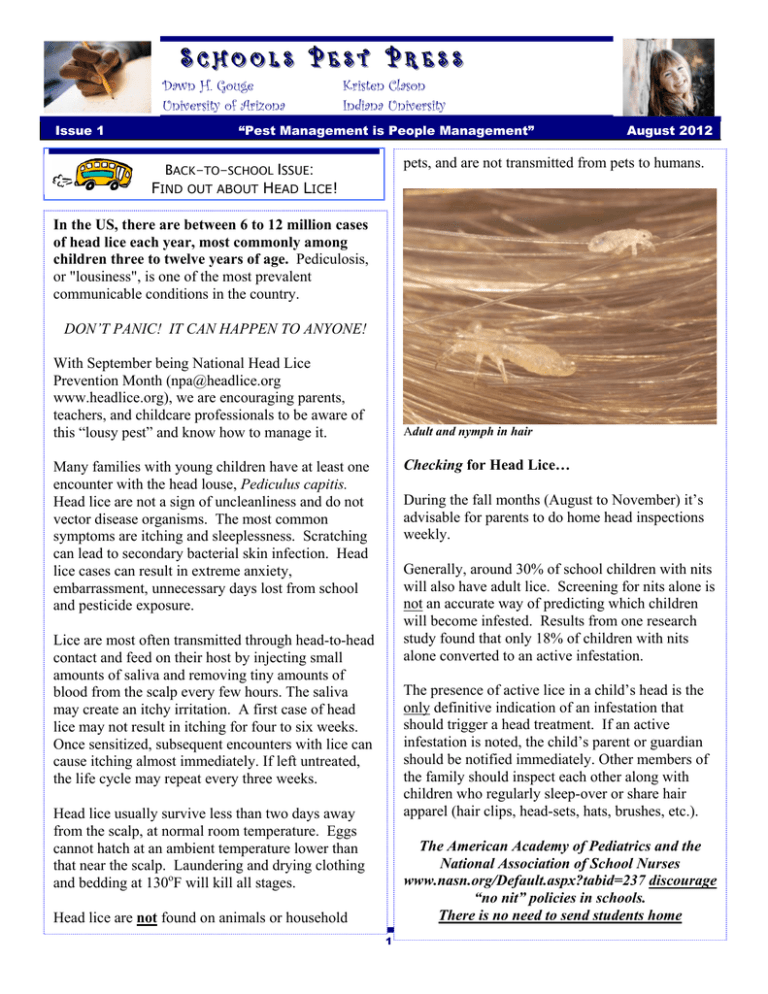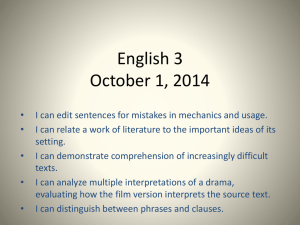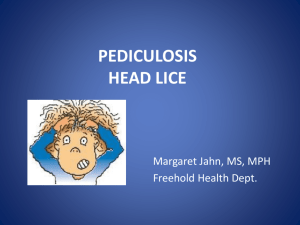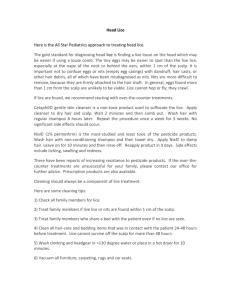S P C
advertisement

SS CC HH OO OO LL SS PP EE SS TT PP RR EE SS SS Dawn H. Gouge University of Arizona Issue 1 Kristen Clason Indiana University “Pest Management is People Management” August 2012 pets, and are not transmitted from pets to humans. BACK-TO-SCHOOL ISSUE: FIND OUT ABOUT HEAD LICE! In the US, there are between 6 to 12 million cases of head lice each year, most commonly among children three to twelve years of age. Pediculosis, or "lousiness", is one of the most prevalent communicable conditions in the country. DON’T PANIC! IT CAN HAPPEN TO ANYONE! With September being National Head Lice Prevention Month (npa@headlice.org www.headlice.org), we are encouraging parents, teachers, and childcare professionals to be aware of this “lousy pest” and know how to manage it. Adult and nymph in hair Checking for Head Lice… Many families with young children have at least one encounter with the head louse, Pediculus capitis. Head lice are not a sign of uncleanliness and do not vector disease organisms. The most common symptoms are itching and sleeplessness. Scratching can lead to secondary bacterial skin infection. Head lice cases can result in extreme anxiety, embarrassment, unnecessary days lost from school and pesticide exposure. During the fall months (August to November) it’s advisable for parents to do home head inspections weekly. Generally, around 30% of school children with nits will also have adult lice. Screening for nits alone is not an accurate way of predicting which children will become infested. Results from one research study found that only 18% of children with nits alone converted to an active infestation. Lice are most often transmitted through head-to-head contact and feed on their host by injecting small amounts of saliva and removing tiny amounts of blood from the scalp every few hours. The saliva may create an itchy irritation. A first case of head lice may not result in itching for four to six weeks. Once sensitized, subsequent encounters with lice can cause itching almost immediately. If left untreated, the life cycle may repeat every three weeks. The presence of active lice in a child’s head is the only definitive indication of an infestation that should trigger a head treatment. If an active infestation is noted, the child’s parent or guardian should be notified immediately. Other members of the family should inspect each other along with children who regularly sleep-over or share hair apparel (hair clips, head-sets, hats, brushes, etc.). Head lice usually survive less than two days away from the scalp, at normal room temperature. Eggs cannot hatch at an ambient temperature lower than that near the scalp. Laundering and drying clothing and bedding at 130oF will kill all stages. The American Academy of Pediatrics and the National Association of School Nurses www.nasn.org/Default.aspx?tabid=237 discourage “no nit” policies in schools. There is no need to send students home Head lice are not found on animals or household 1 Controlling Nits and Adult Lice… Since lice spread through head-to-head contact, where possible, place hats, scarves and coats on hooks or in separate lockers or cubbies to avoid contact. If hooks are shared or clustered, have children place their coats and hats in sealed plastic bags, especially if head lice are present. Manual removal of nits close to the head is always recommended. Fine-toothed "nit combs" are helpful. Combing and brushing hair damages lice and eggs significantly. Use of a hair dryer further injures adults, nymphs and nits. Manual removal steps: 1. Comb and divide hair into sections, use a metal fine toothed louse comb to remove nits and lice. After combing each section dip the comb in a container of hot soapy water to remove lice and nits. 2. Repeat until all the sections of hair have been systematically combed. 3. Clean nit removal comb, clips, brushes, headphones, hats, etc. with hot soapy water. 6 months or older. Risks are minimal compared to some of the alternatives, and the product has proven to be extremely effective. When using a head louse shampoo, minimize body exposure by confining the insecticide to the head hair. Wash the infested person's hair in a basin or sink so insecticide residues do not reach other parts of the body. The person applying the treatment should wear rubber gloves. Never apply an insecticide to anyone who has open cuts, scratches, or inflammations, and never use these materials on infants without consulting a doctor. In all cases, follow label directions completely and carefully. With pyrethrin and permethrin shampoos, lice should die within 10 to 30 minutes after treatment. If you find live lice after 30 minutes, resistance may be occurring and you should discontinue use of that product. Never ever resort to dangerous practices such as applying general use insecticides, or materials such as kerosene! Unfortunately, there are few independent studies indicating the benefits of nit removal aids or occlusive substances including "petrolatum shampoos". Other occlusive substances have been suggested (mayonnaise, tub margarine, herbal oils, olive oil) but benefits have not been demonstrated. Special combs are needed for louse removal and will be effective in eradicating head lice infestations only if used diligently each day for up to two weeks. Drying and brushing the hair with a hair dryer will kill many lice which are very delicate and prone to desiccation. Head lice shampoos contain insecticides and if they are not used properly can be very hazardous. What needs to be done in the home? Once an infestation is detected, all clothes should be washed in hot soapy water. Pillowcases, sheets, blankets and other bedding material should also be washed and placed in the clothes dryer on the "high heat" cycle to kill the lice and their eggs. Any nonwashable items should be dry cleaned or sealed in plastic bags and placed in the freezer at 50F or lower for 10 hours or more. Vacuuming the home will remove shed hair and nits. Continue weekly head checks of the whole family. Removing nits close to the head is usually included in the treatment instructions. Most products warn against using the products on broken skin which is practically impossible given that lice-related itching usually leads to excoriation of the scalp, which may be severe. If repeated treatments fail, some physicians will prescribe higher levels of permethrin (5%), lindane or malathion, or even scabies treatments (e.g. crotamiton, sulfamethoxazole, trimethoprim, ivermectin, etc.). These may be extremely hazardous to children, despite being FDA approved. Ulesfia (benzyl alcohol) is a relatively new prescriptive treatment for head lice on children To find out about YOUR school’s policy and procedures for children discovered with lice, check with your school nurse’s office. For more information see: Green, T. A., and D. H. Gouge, eds. 2010. School IPM 2015: A Strategic Plan for Integrated Pest Management in Schools in the United States. http://www.ipminstitute.org/school_ipm_2015/resources.htm 2





